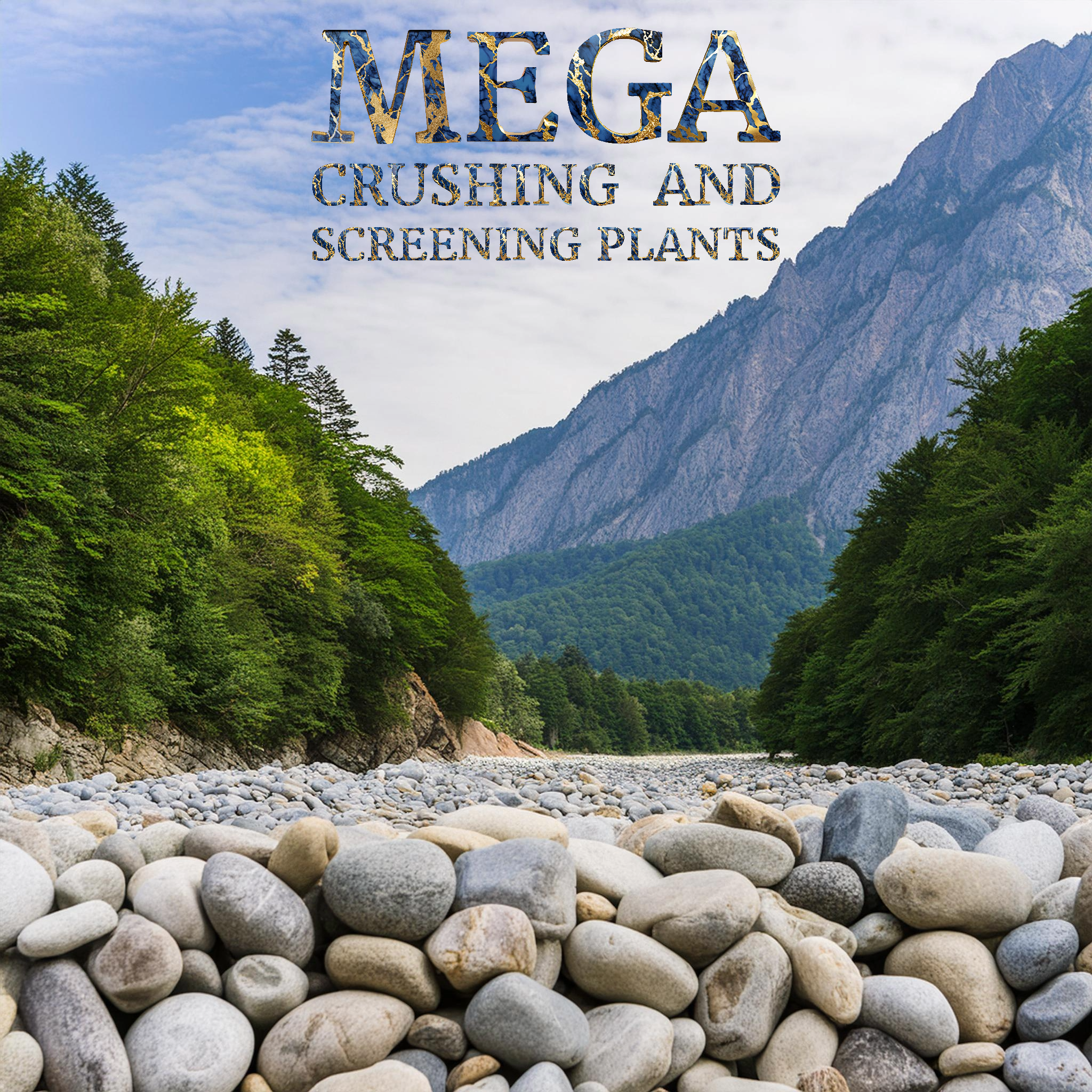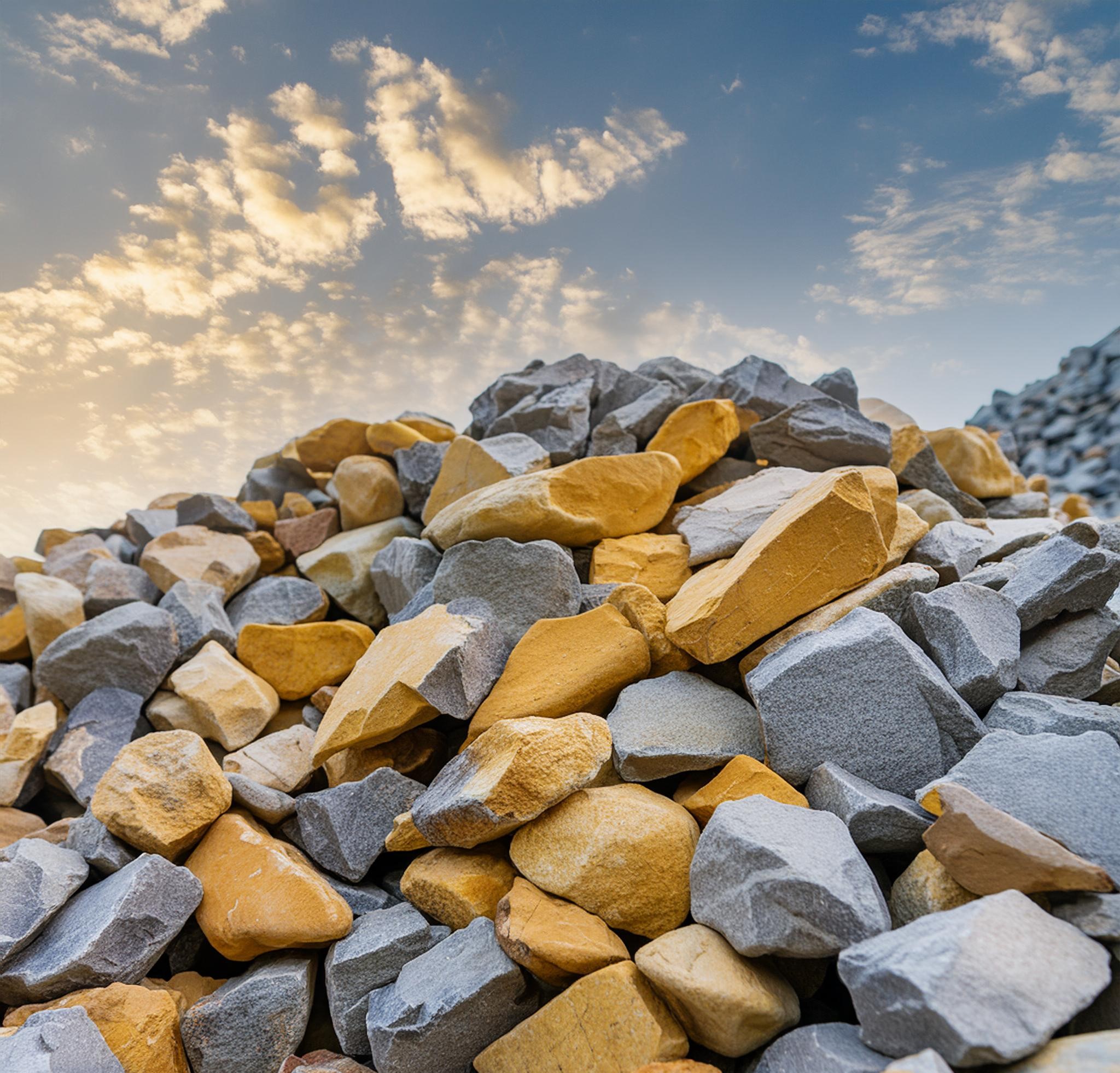What are the Crusher Types To Be Used For Mountain and River Materials? In construction projects, the utilization of river and mountain materials is essential, e.g concrete production. Crushing and screening plants play a pivotal role in processing these resources effectively. This discourse explores the key components and operational disparities between river material and mountain material crushing plants, aiding stakeholders in optimizing their construction endeavors.
River Material Crushing And Screening Plants
River material (rock & pebble) is a naturally occurring and essential component in many construction projects.
High-quality materials such as stone, gravel, and sand (aggregate) are used in various applications, ranging from foundational structures to road construction. However, to achieve the desired size and quality of these valuable materials, a proper solution is required.
This is where river material crushing and screening plants come into play. These plants offer an effective and efficient solution for the crushing, screening, and production of the final product from natural materials.
They are an important equipment widely used in the construction industry and quarries. These plants crush the river materials (rock & pebble) to the desired size, classify them with specially designed screens and make them ready for use as end products.
The important components of the river material crushing and screening plant are as follows:
Feeding System For River Material
River material crushing and screening plant is equipped with an efficient feeding system to ensure proper feeding of materials. Components such as a feeding belt or feeding hopper enable the smooth and continuous transfer of materials into the crusher.
Crushing Units For River Material
The river material crushing and screening plant consists of different crusher units.These are generally impact crushers or cone crushers. These crushers break down the materials at high speed to achieve the desired size.
Screening System For River Material
After the crushing process, screening systems are utilized to separate and classify materials into desired sizes. Screens effectively segregate materials of different sizes, enabling the production of high-quality products.
Conveyor Belts For River Material
Material transportation operations are carried out through conveyor belts in the river material crushing and screening plant. These belts ensure the safe transportation of materials from the crusher to the screening system and final product storage area.
Control and Automation System
Control and automation systems are used for the effective operation of the stream material crushing and screening plant. These systems ensure efficient management of the plant, monitoring and control of the equipment.
Important components and additional equipment can be used according to the needs of the plant.
For instance, equipment such as anti-vibration systems, sound insulation and dust control may be preferred to improve working conditions and reduce environmental impacts.
Mountain in Material Crushing And Screening Plants
Mountain materials are an important component in the construction industry and are used in many projects also.
Crushing and classifying these materials to the appropriate size is a critical step to obtain quality construction materials. In these plants, which are used to crush hard and natural stones, gravels and sands and bring them to the desired size, various types of crushers such as jaw crushers, impact crushers and cone crushers are generally used.
Each type of crusher must be selected according to the material properties and the final specifications of the desired product.
What are the Important components in a mountain material crushing and screening plant?
Feeding System
Feeding system is one of the key components of a mountain material crushing and screening plant. This system ensures a proper and continuous feeding of materials into the crusher. Components such as the feed belt or hopper control and regulate the flow of materials into the crusher.
Crusher Units
There are various crusher units in the mountain material crushing and screening plant. Crusher units are used to crush materials to the desired size. Impact crushers crush materials with high-speed impacts and bring them to the desired size. Cone crushers, on the other hand, crush the materials by compression and separate them into desired sizes. Visit our blog for more information about crushers.
Screening System
After the crushing process, screening systems are used to separate and classify the crushed materials into desired sizes. Sieves separate the materials into different sizes and ensure that quality products are obtained. In this way, products of appropriate size and quality are obtained for the use of the materials.
Conveyor Belts
Material transportation in the mountain material crushing and screening plant is carried out by conveyor belts. These conveyor belts transport the material from the crusher to the screening system and the final product storage area. Conveyor belts automate the material handling process and reduce labor.
Control and Automation System
Control and automation systems are used for efficient and effective operation of mountain material crushing and screening plants. Control and automation systems monitor, control and properly manage all components of the plant. Furthermore, automation systems optimize the operation of the plant and save energy.
Differences Between River Materials Crushing Plant and Mountain Materials Crushing Plant
Material Properties
River materials and mountain materials can show differences in terms of physical properties.
River materials are generally smaller in size, have smoother shapes, and a softer structure. On the other hand, mountain materials can be larger in size, have sharp edges, and be harder. This difference can have an impact on the design and equipment selection of crushing and screening plants.
Crushing And Screening Process
River materials may generally require fewer crushing stages in crushing and screening plants.
Since the material is usually smaller in size and more homogeneous, the crushing process may require less energy. Mountain materials, on the other hand, are generally larger in size and more brittle, so more crushing steps may be required.
Equipment Selection
More powerful crushers and screening systems may be preferred to crush large-sized rock fragments.
In mountain material crushing and screening plants, stronger and more durable equipment can be used. For river materials, smaller-sized equipment can be used.
The construction industry relies heavily on concrete, and a key ingredient in concrete is aggregate.
Obtaining Aggregates for Concrete Batching Plants
Concrete requires aggregates of various sizes to achieve optimal strength and workability. Crushing and screening plants play a vital role in transforming raw materials into these precise gradations. Here’s a breakdown of the process:
- Raw Material Selection: The first step involves selecting suitable raw materials. Granite, basalt, limestone, and recycled concrete are some of the most common choices. The chosen material should be strong, clean, and free from impurities that can affect concrete quality.
- Crushing: The raw material is fed into the crushing plant. Jaw crushers are often used for the initial breakdown of large rocks. Subsequently, cone crushers or impact crushers further reduce the size of the material.
- Screening: After crushing, the material is passed through vibrating screens with different mesh sizes. Each screen separates the aggregate into specific size fractions, such as coarse aggregate (gravel) and fine aggregate (sand).
- Stockpiling: The sized aggregates are then stockpiled in separate bins or piles for easy access by the concrete batching plant.
Considerations for Setting Up a Crushing and Screening Plant
Before embarking on your crushing venture, here are some crucial factors to keep in mind:
- Production Capacity: Determine the amount of aggregate your concrete batching plant will require and size your crushing plant accordingly.
- Material Characteristics: The properties of your chosen raw material will influence the type of crushers and screens needed. For example, harder rocks might necessitate more powerful crushing machinery.
- Environmental Regulations: Ensure your plant complies with all environmental regulations regarding dust control and noise pollution.
- Permitting: Obtain the necessary permits for operating a crushing plant in your area.
Most Used Aggregates in Concrete Batching Plants
- Coarse Aggregate (Gravel): Typically ranges in size from 9.5 mm to 63 mm (⅜” to 2 ½”). Provides strength and stability to the concrete mix.
- Fine Aggregate (Sand): Generally falls within the range of 0.075 mm to 4.75 mm ( No. 200 sieve to ⅜”). Fills voids between coarse aggregate particles and contributes to workability.
Choosing the Best Raw Material for Concrete Production
The ideal raw material for concrete aggregates should possess the following characteristics:
- Strength: The aggregate should be strong and durable to withstand the stresses placed on concrete structures.
- Cleanliness: Free from contaminants like clay or organic material that can weaken the concrete bond.
- Shape: Angular-shaped aggregates create better interlocking, leading to stronger concrete.
- Grading: Consistent particle size distribution is crucial for optimal concrete properties.
Stockpiling Aggregates
Proper stockpiling practices ensure the consistent quality and availability of aggregates for the concrete batching plant. Here are some key points:
- Separate Stockpiles: Maintain separate stockpiles for each aggregate size to prevent mixing and ensure proper batching.
- Drainage: Ensure proper drainage to prevent stockpiles from becoming waterlogged, which can affect aggregate quality.
- Inventory Management: Implement a system to track inventory levels and prevent stockouts that could disrupt concrete production.
Operating a Crushing and Screening Plant
Operating a crushing and screening plant efficiently requires proper training and adherence to safety protocols. Here’s a glimpse into the key aspects:
- Equipment Maintenance: Regularly schedule maintenance for crushers, screens, and conveyors to prevent breakdowns and ensure optimal performance.
- Dust Control: Implement dust suppression measures to comply with regulations and create a safer working environment.
- Operator Training: Train plant operators on safe operation procedures, equipment functionality, and troubleshooting basic issues.
By understanding the process of obtaining aggregates, the crucial considerations for setting up a crushing plant, and the importance of proper operation, you can ensure a steady supply of high-quality aggregates for your concrete batching plant. This, in turn, translates to efficient concrete production and successful construction projects.
Production Quality
Crushing and screening plants for river materials often produce more homogeneous and uniformly shaped products. This is important in construction projects where more precise measurements and regulations are needed. On the other hand, the products obtained in mountain materials crushing and screening plants can often be more varied in size and coarser.
Operating Conditions
Mountain materials crushing and screening plants are often designed to withstand more demanding operating conditions. Crushing and conveying large rock fragments may require more intensive work. River materials crushing and screening plants, on the other hand, work with smaller and lighter materials, so operating conditions may be less challenging.
These differences are the main distinctions between a river materials crushing plant and a mountain materials crushing plant.
Each plant should be designed in a customized way according to the material properties and equipment should be selected to meet the needs.
While the river materials crushing plant is preferred for projects requiring more precise sizing and homogeneity, the mountain materials crushing plant may be a more suitable option for the crushing and screening of larger and harder materials.
However, both plants contain important components. The feeding system ensures that the material is delivered smoothly to the crusher. The crusher units play a critical role in crushing the materials to the desired sizes.
The screening system is used to classify and separate the crushed materials into desired sizes. Conveyor belts are used to transport the material and ensure the flow in the process. The control and automation system ensures that the plant operates efficiently and manages the operational processes.
Optional equipment can vary according to the needs of the plant. These may include anti-vibration systems, sound insulation, dust control, electrical generators, etc. This equipment improves working conditions, increases safety and reduces environmental impact.
The river materials crushing and screening plant and the mountain materials crushing and screening plant should be designed for different material properties and work requirements.
With the right equipment selection and design, each plant will ensure optimum performance and provide users with high quality end products.


